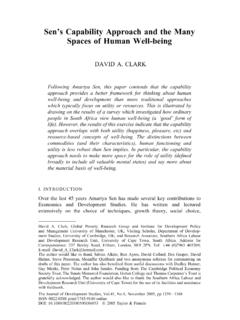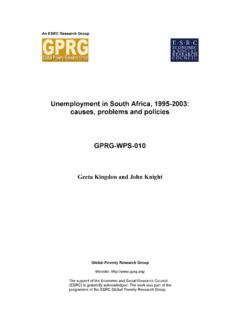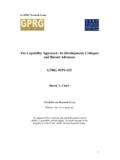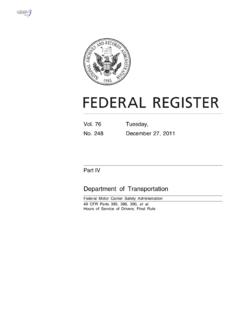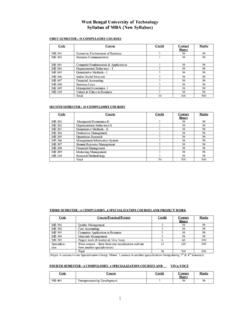Transcription of A Gendered Analysis of ‘Time Poverty’ – The …
1 An ESRC Research Group A Gendered Analysis of Time Poverty The Importance of Infrastructure GPRG-WPS-078 David Lawson Global Poverty Research Group Website: The support of the Economic and Social Research Council (ESRC) is gratefully acknowledged. The work was part of the programme of the ESRC Global Poverty Research Group. 1 A Gendered Analysis of Time Poverty The Importance of Infrastructure David Lawson Abstract This paper uses a combination of nationally representative individual level time use data combined with household and community data to further our understanding of time use, and how infrastructure impacts on gender disaggregated time poverty.
2 With a common, and growing, perception in the empirical literature being that Sub Saharan African females are typically disadvantaged in market based activities because of the large time burden of having to undertake both formal work and domestic duties, it is important to understand some of these key processes and issues that underpin, and link with, poverty reduction. Using nationally representative from Lesotho we are able to provide unique insights into gender related, formal and informal, work allocations and specifically obtain insights regarding the main determinants of those who are time poor and how key infrastructural elements impact on this.
3 Key words: Time Poverty, Time Use, Gender, Lesotho, Infrastructure 2 1. Introduction The Analysis of concepts and applications of poverty, particularly from an economist s perspectives, are commonly limited to monetarily defined measures such as the use of consumption, income, or the construction of an asset index. Throughout the 1990 s such measures have risen in popularity as the collection of nationally based household data has become more common. Although these approaches have extended our understanding of the complexity of the processes underlying poverty reduction (Moser and Felton 2006), they are almost always limited by the major drawback of only being able to disaggregate to the household level.
4 Hence, such measures are restrictive in their capacity to analyse individual level poverty/welfare, intra-households activity, and other very important non monetary defined welfare based policy issues. Considering the increasing emphasis to consider non income based measures of welfare (Gunther and Klasen, 2006), recent research (Hammersmith and Pfann, 2005) is increasingly noting the benefits of using time using time use data, and appropriate concepts that can arise from this.
5 However, it should be noted that the use of such data is not solely limited to the application of welfare issues, but also a number of other areas of development. For example, time use data allows for particularly unique assessment of intra-household issues, limitations individuals have in their labour supply, and has provided, at least limited, findings on important policy issues such as how infrastructure impacts on time usage. For example the failure to provide adequate or affordable infrastructure facilities and services for low income users, has often been associated with negative social impacts of inappropriate provision (Masika and Baden 1997:1).
6 Despite this increased focus however, to date this has rarely resulted in quantitative based investigations into such issues. The aim of this paper is therefore to consider a different poverty concept that has its origins in the same way monetary based poverty based welfare measures are calculated, but allows us to add to our understanding of deprivation and our non income based poverty knowledge. We achieve this by using time use data, from Lesotho, and 3calculating a time poverty measure.
7 By adopting such an approach and combining this with infrastructure data, the paper provides a contribution to improving our ability to identify effective policy relevant interventions, focussing on gender differentials of time use, through infrastructure, and on the determinants of time poverty. We approach the Analysis of time use through two main methods. Firstly, we analyse the time spent on different types of activities, and disaggregate this by gender. However, because Lesotho s latest Household Budget Survey (HBS), 2002, is particularly rich regarding infrastructure data, we are also able to provide a unique focus on the impact certain types of infrastructure has on individuals time use.
8 The second, complementary method, adopts a concept of time poverty similar to that adopted by Bardasi and Wodon (2006) which basically considers the time an individual spends on productive activities such as working, farming, domestic and other duties (collecting firewood etc.) from which an individual can then be defined as time poor . Lesotho is a particularly interesting case to study the determinants of time poverty, and impact of infrastructure. Although the country is relatively small, with a population of approximately 2 million, a number of characteristics specific to Lesotho are relevant to a number of SSA countries.
9 In particular, despite some very limited progress in reducing consumption based poverty, some parts of the country have had limited infrastructure investment, with for example very limited transport networks in remote rural areas, and the country also has one of the highest HIV/AIDS levels in the SSA (43% for women in their late 30 s, and 41% for men 30-34 aged) a disease that places huge time, and economic, burden on individuals and families. The paper is structured as follows.
10 Section 2 outlines the models used to estimate the determinants of time poverty with the data and variables employed. Section 3 presents some descriptive statistics disaggregated by gender, and Section 4 reports on the results of the econometric Analysis of the determinants of time poverty. Section 5 concludes. 42. Methods and Data As stated by Vickery (1977) if one is to calculate the minimal level of consumption, then this requires both money and household production, of which time use is a major component of the latter.
